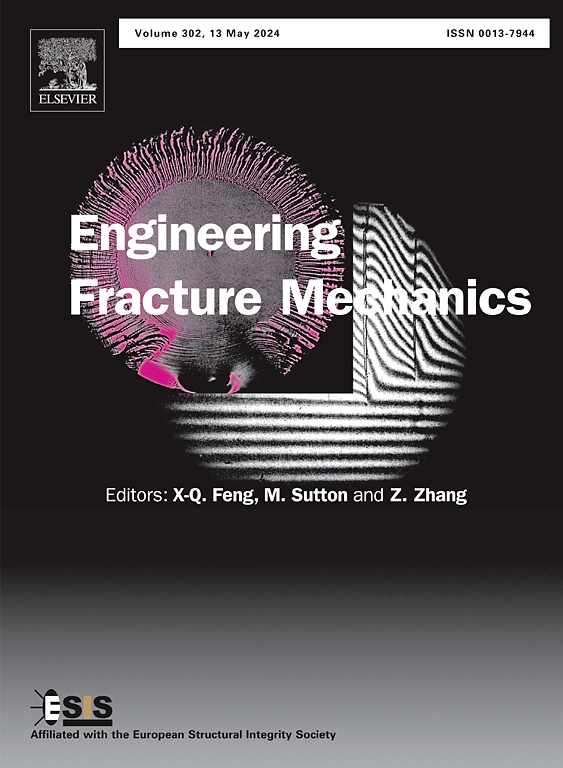Anisotropic magneto-electro-elastic fracture mechanics in orthotropic materials: Analysis using efficient interpolating modified MLS-based EFGMs and interaction integral
IF 4.7
2区 工程技术
Q1 MECHANICS
引用次数: 0
Abstract
Wendland’s radial basis function-based Interpolating Modified Moving Least Squares (IMMLS) based element-free Galerkin method (EFGM) is an efficient numerical technique which is developed to ameliorate the classical Moving Least Squares Approximation (MLSA) based EFGM. On the other hand, regularized IMMLS-based EFGM (IN-EFGM) is well-explored in tissue deformation and fracture mechanics problems. Anisotropic magneto-electro-elastic (MEE) analysis featuring strong discontinuities is well-established in the finite element method (FEM) and among others. However, MEE analysis has not been explored with in classical MLSA, IN-EFGM, and Wendland’s IMMLS-based EFGM (WiN-EFGM). To address this gap, the present work explores anisotropic MEE fracture mechanics (AMEE-FM) analysis to evaluate the extended stress intensity factors (ESIFs) using interaction integral method using EFGM in general. Benchmark numerical experiments are validated with analytical solutions and amongst the other are performed on simple and complex domains by considering an embedded crack under a steady state condition. The results of field variables in WiN-EFGM and IN-EFGM are corroborated with converged classical MLSA-based EFGM results. The extended stress intensity factors are evaluated using the interaction integral. norm with reference to classical MLSA-based EFGM shows that field variables have an overall better match in WiN-EFGM and IN-EFGM techniques. The field variables in WiN-EFGM have overall nearly same error as compared to IN-EFGM. The potential advantages of efficient WiN-EFGM and IN-EFGM over classical MLSA include ensuring essential boundary conditions, unique solution due to a non-singular moment matrix, and lesser computational time. Thus, interpolating EFGM offers an alternate tool to explore the AMEE fracture mechanics to evaluate the ESIFs.
正交异性材料的各向异性磁-电弹性断裂力学:利用有效插值修正的基于mls的EFGMs和相互作用积分进行分析
Wendland基于径向基函数插值修正移动最小二乘(IMMLS)的无单元伽辽金法(EFGM)是一种改进经典移动最小二乘逼近(MLSA)的有效数值方法。另一方面,基于正则化imls的EFGM (in -EFGM)在组织变形和断裂力学问题上得到了很好的探索。具有强不连续的各向异性磁电弹性(MEE)分析在有限元法(FEM)和其他方法中得到了广泛的应用。然而,MEE分析尚未与经典的MLSA、in -EFGM和Wendland基于imls的EFGM (WiN-EFGM)进行探讨。为了解决这一问题,本研究探索了各向异性MEE断裂力学(AMEE-FM)分析,利用EFGM的相互作用积分法评估扩展应力强度因子(esif)。采用解析解对基准数值试验进行了验证,并考虑了稳态条件下的嵌入裂纹,在简单域和复杂域分别进行了数值试验。WiN-EFGM和in -EFGM的场变量计算结果与经典的基于mlsa的EFGM结果进行了验证。采用相互作用积分法对扩展应力强度因子进行了计算。参考经典的基于mlsa的EFGM, L2范数表明WiN-EFGM和in -EFGM技术的场变量总体上具有更好的匹配性。WiN-EFGM中的字段变量与in - efgm的总体误差几乎相同。与经典MLSA相比,高效WiN-EFGM和IN-EFGM的潜在优势包括确保必要的边界条件、非奇异矩矩阵的唯一解以及更少的计算时间。因此,内插EFGM为研究AMEE断裂力学以评估esif提供了另一种工具。
本文章由计算机程序翻译,如有差异,请以英文原文为准。
求助全文
约1分钟内获得全文
求助全文
来源期刊
CiteScore
8.70
自引率
13.00%
发文量
606
审稿时长
74 days
期刊介绍:
EFM covers a broad range of topics in fracture mechanics to be of interest and use to both researchers and practitioners. Contributions are welcome which address the fracture behavior of conventional engineering material systems as well as newly emerging material systems. Contributions on developments in the areas of mechanics and materials science strongly related to fracture mechanics are also welcome. Papers on fatigue are welcome if they treat the fatigue process using the methods of fracture mechanics.

 求助内容:
求助内容: 应助结果提醒方式:
应助结果提醒方式:


